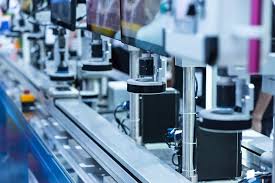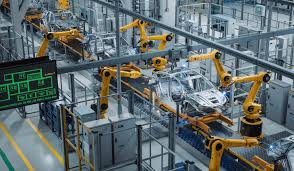In the contemporary global industrial landscape, the influence and development of eastern industrial automation have emerged as a significant force. Eastern countries, including China, Japan, South Korea, and others, have been making remarkable strides in the field of industrial automation, leveraging technological advancements, skilled labor, and a growing emphasis on innovation. This article will delve deep into the various aspects of eastern industrial automation, from its historical evolution to its current status, key players, applications, and future prospects. 🚀
A Historical Perspective of Eastern Industrial Automation

The journey of eastern industrial automation has been one of continuous growth and transformation. In Japan, the post-World War II era witnessed a rapid industrialization drive. The country quickly embraced automation technologies to rebuild its manufacturing base. Japanese companies, such as Fanuc and Mitsubishi Electric, emerged as global leaders in the production of industrial robots and automation systems. Fanuc, for instance, started as a small company focused on numerical control systems and gradually expanded its product portfolio to include a wide range of high-precision industrial robots used in automotive manufacturing, electronics assembly, and other industries.
China, on the other hand, has experienced an exponential growth in industrial automation over the past few decades. The Chinese government’s initiatives to promote technological innovation and upgrade traditional industries have played a crucial role. In the early days, China relied on importing automation technologies and equipment. However, with the development of its domestic research and development capabilities, Chinese companies have started to produce their own automation solutions. Companies like Shenzhen Inovance Technology Co., Ltd. have made significant progress in areas such as programmable logic controllers (PLCs), servo systems, and industrial robots.
South Korea has also been a major player in eastern industrial automation, especially in the electronics and semiconductor industries. Samsung and LG, two of South Korea’s largest conglomerates, have invested heavily in automation technologies to improve the efficiency and quality of their manufacturing processes. In the semiconductor manufacturing sector, South Korean companies have been at the forefront of adopting advanced automation systems to ensure high precision and productivity.

Let’s summarize the historical development of key eastern countries in industrial automation in a table:
| Country | Initial Phase | Current Status | Key Players |
|---|---|---|---|
| Japan | Post-WWII industrialization drive, focused on rebuilding manufacturing with automation. | Global leader in industrial robots and automation systems. | Fanuc, Mitsubishi Electric, Yaskawa Electric |
| China | Initially relied on imports, then developed domestic R&D capabilities. | Rapid growth, with domestic companies producing a wide range of automation solutions. | Shenzhen Inovance Technology, Estun Automation, Siasun Robot & Automation |
| South Korea | Focused on electronics and semiconductor industries, heavy investment in automation. | Advanced in semiconductor manufacturing automation and consumer electronics production automation. | Samsung, LG, Hynix Semiconductor |
Current Status of Eastern Industrial Automation
The eastern industrial automation market is currently a vibrant and dynamic ecosystem. It encompasses a wide range of industries, from traditional manufacturing to emerging sectors such as 新能源 (new energy) and smart manufacturing.
In the manufacturing industry, eastern countries are leading the way in implementing advanced automation technologies. For example, in the automotive industry, robotic assembly lines are becoming the norm. In China, major automotive manufacturers like Geely and BYD are increasingly using industrial robots for tasks such as welding, painting, and assembly. These robots can work with high precision and speed, reducing production time and improving product quality.
The electronics industry in the East is also highly automated. In Japan, companies are using advanced automation systems to produce high-tech electronic components with extremely fine tolerances. South Korea’s semiconductor manufacturing facilities are equipped with state-of-the-art automation systems that can handle complex manufacturing processes with minimal human intervention.
The new energy sector in eastern countries is also seeing a significant adoption of industrial automation. In the production of solar panels and wind turbines, automation is used to ensure the precision and efficiency of manufacturing processes. Chinese companies are at the forefront of this trend, with many solar panel manufacturing plants relying on automated production lines to increase production capacity and reduce costs.
Here’s a table highlighting the current applications of eastern industrial automation in different industries:
| Industry | Application of Eastern Industrial Automation | Benefits |
|---|---|---|
| Automotive | Robotic assembly lines for welding, painting, and assembly. | Increased production speed, improved quality, reduced labor costs. |
| Electronics | Automated production of high-tech components with fine tolerances. | Higher precision, increased productivity, better product consistency. |
| New Energy (Solar and Wind) | Automated production lines for solar panels and wind turbines. | Increased production capacity, reduced costs, improved product quality. |
Key Players in Eastern Industrial Automation
Japan

- Fanuc: A global leader in industrial robotics, Fanuc offers a wide range of robots with different payloads and reach capabilities. Their robots are used in various industries, including automotive, electronics, and food processing. Fanuc’s robots are known for their high precision, reliability, and advanced control systems.
- Mitsubishi Electric: This company is renowned for its automation products, including PLCs, servo systems, and human-machine interfaces (HMIs). Mitsubishi Electric’s products are widely used in industrial automation applications, providing seamless control and monitoring of industrial processes.
China
- Shenzhen Inovance Technology Co., Ltd.: Specializes in the research, development, production, and sales of industrial automation products. Their product portfolio includes PLCs, servo drives, and industrial robots. Inovance Technology has made significant inroads in the domestic and international markets with its cost-effective and high-performance products.
- Estun Automation: A leading provider of industrial automation solutions in China. Estun Automation offers a comprehensive range of products, including industrial robots, motion control systems, and intelligent manufacturing solutions. Their products are widely used in industries such as automotive, electronics, and metal processing.
South Korea
- Samsung: In addition to its dominance in the consumer electronics market, Samsung is also a major player in industrial automation. The company uses advanced automation technologies in its semiconductor manufacturing facilities and consumer electronics production lines to ensure high efficiency and quality.
- LG: LG is another South Korean conglomerate that invests heavily in industrial automation. In its appliance manufacturing plants, LG uses automation systems to improve production processes and reduce costs.
Let’s compare these key players in a table:
| Country | Key Player | Main Product Offerings | Industry Presence |
|---|---|---|---|
| Japan | Fanuc | Industrial robots with various payloads and reach capabilities. | Automotive, electronics, food processing, etc. |
| Japan | Mitsubishi Electric | PLCs, servo systems, HMIs. | Wide range of industrial automation applications. |
| China | Shenzhen Inovance Technology Co., Ltd. | PLCs, servo drives, industrial robots. | Domestic and international markets, various industries. |
| China | Estun Automation | Industrial robots, motion control systems, intelligent manufacturing solutions. | Automotive, electronics, metal processing. |
| South Korea | Samsung | Advanced automation systems for semiconductor and consumer electronics manufacturing. | Semiconductor and consumer electronics industries. |
| South Korea | LG | Automation systems for appliance manufacturing. | Appliance manufacturing industry. |
Future Prospects of Eastern Industrial Automation

The future of eastern industrial automation looks extremely promising, driven by several key factors.
One of the major drivers is the continuous advancement of technologies such as artificial intelligence (AI), the Internet of Things (IoT), and 5G. AI and machine learning algorithms can be integrated into industrial automation systems to enable predictive maintenance, quality control, and process optimization. For example, in a manufacturing plant, AI can analyze data from sensors to predict when a machine is likely to fail, allowing for timely maintenance and reducing downtime.
The IoT is also set to revolutionize eastern industrial automation. With the proliferation of IoT devices, industrial systems can be connected and monitored in real-time. This enables remote control, data analytics, and the implementation of smart manufacturing concepts. In China, the government’s push for the development of smart manufacturing initiatives is expected to further accelerate the adoption of IoT in industrial automation.
5G technology will provide high-speed, low-latency communication, which is essential for the seamless operation of industrial automation systems. It will enable faster data transfer between devices, ensuring real-time control and monitoring of industrial processes.
Another important trend is the increasing focus on sustainable manufacturing. Eastern countries are placing a greater emphasis on environmental protection and energy efficiency. Industrial automation can play a crucial role in achieving these goals by optimizing production processes, reducing waste, and improving energy utilization.
In conclusion, eastern industrial automation has come a long way and has established itself as a significant force in the global industrial landscape. With its rich history, current technological advancements, and promising future prospects, the eastern industrial automation industry is set to continue its growth trajectory. The key players in this field will continue to innovate and develop new technologies, driving the adoption of automation across various industries. As eastern countries further invest in research and development and promote the integration of emerging technologies, the future of industrial automation in the East looks bright, with the potential to bring about significant changes in the global manufacturing and industrial sectors. 🌟
